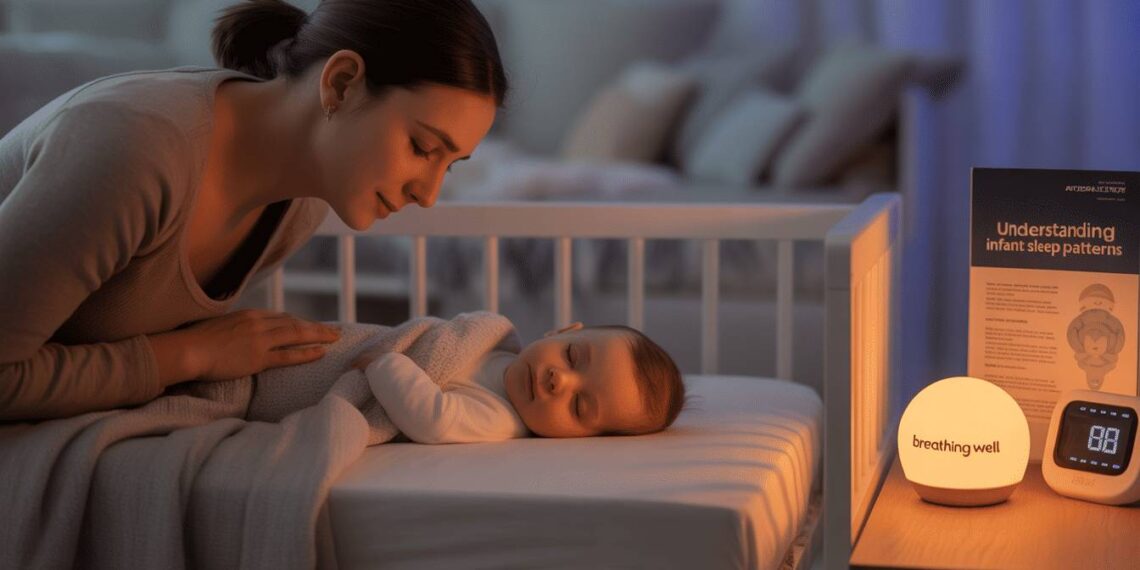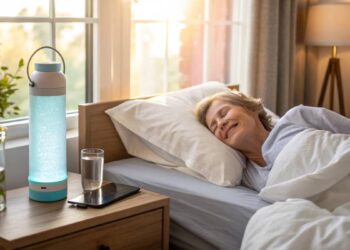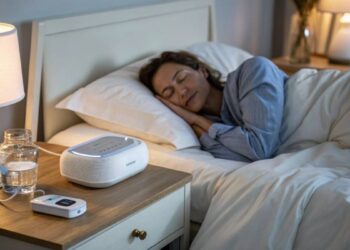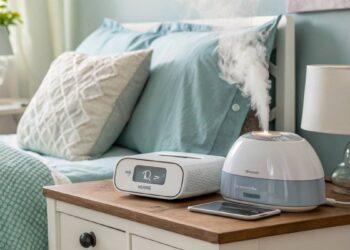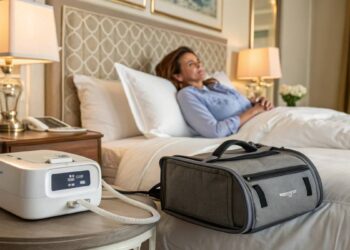Ever watched your baby sleep and noticed something that made your heart skip a beat—a pause in their breathing, an unusual snort, or a gasping sound? These could be signs of infant sleep apnea, a condition that affects breathing during sleep but often goes undiagnosed. While the thought of breathing interruptions in your precious little one can be terrifying, understanding this condition is the first step toward ensuring your baby’s safety and well-being during those vulnerable sleeping hours.
Key Takeaways
- Infant sleep apnea involves interruptions in breathing during sleep, classified as either Obstructive Sleep Apnea (OSA) or Central Sleep Apnea (CSA)
- Premature birth, neurological disorders, and anatomical factors are common causes of infant sleep apnea
- Key warning signs include breathing pauses, unusual snoring, gasping, restless sleep, and skin color changes
- Early diagnosis through sleep studies and proper medical assessment is crucial for effective treatment
- Treatment options range from environmental adjustments to CPAP therapy or surgery in severe cases
- Untreated sleep apnea can impact infant development, behavior, weight, and long-term health
Understanding Infant Sleep Apnea
Infant sleep apnea messes with a baby’s breathing while they snooze. This section discusses what sleep apnea in infants is all about and what might cause it.
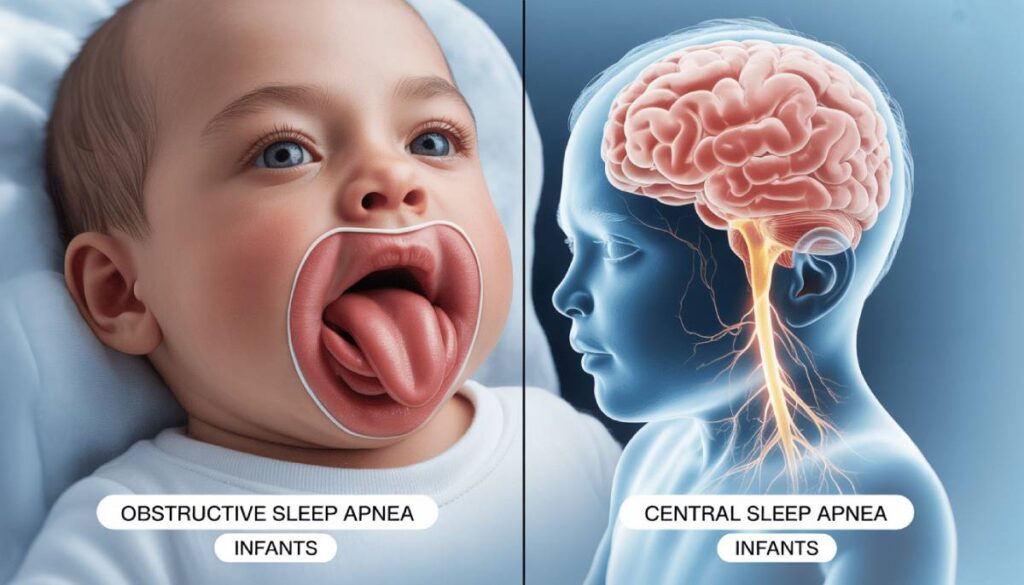
What is Sleep Apnea in Infants?
Sleep apnea in infants is like a pesky hiccup. Breathing gets interrupted over and over during sleep. These pauses might last just a few seconds or stretch longer and can happen several times a night. There are two main troublemakers:
- Obstructive Sleep Apnea (OSA): The airway is a little blocked, like a crumpled straw, making it hard for air to move smoothly through the throat.
- Central Sleep Apnea (CSA): The brain doesn’t always send the “breathe now” signal to the breathing muscles.
Check out detailed info in our write-ups on obstructive sleep apnea and central sleep apnea.
“Sleep is the golden chain that ties health and our bodies together, especially for developing infants whose bodies are working overtime even during rest.” – Dr. Sarah Johnson, Pediatric Sleep Specialist
Causes of Infant Sleep Apnea
There are a bunch of reasons why sleep apnea might show up in infants. Figuring out these causes helps parents and docs deal with it better.
| Cause | Description |
|---|---|
| Premature Birth | Babies born early often have brain parts that aren’t fully grown yet, which messes with breathing patterns. |
| Neurological Disorders | Health issues like brain defects from birth or other nerve problems can lead to central sleep apnea. |
| Obstructive Factors | Things like large tonsils or adenoids can block the airway, causing obstructive sleep apnea. |
| Genetic Factors | Some babies might get genetic quirks that make them more likely to develop sleep apnea. |
For a closer look at why sleep apnea happens, check our piece on sleep apnea causes.
Grasping what infant sleep apnea is and why it occurs can help parents spot it and get the right help for their kids. Find more about symptoms and treatments in our sections on sleep apnea symptoms and sleep apnea treatment.
Signs and Symptoms
Figuring out if a baby has sleep apnea can be a game-changer for their health and growth. Catching it early leads to better treatment and outcomes, giving your little one the best start.
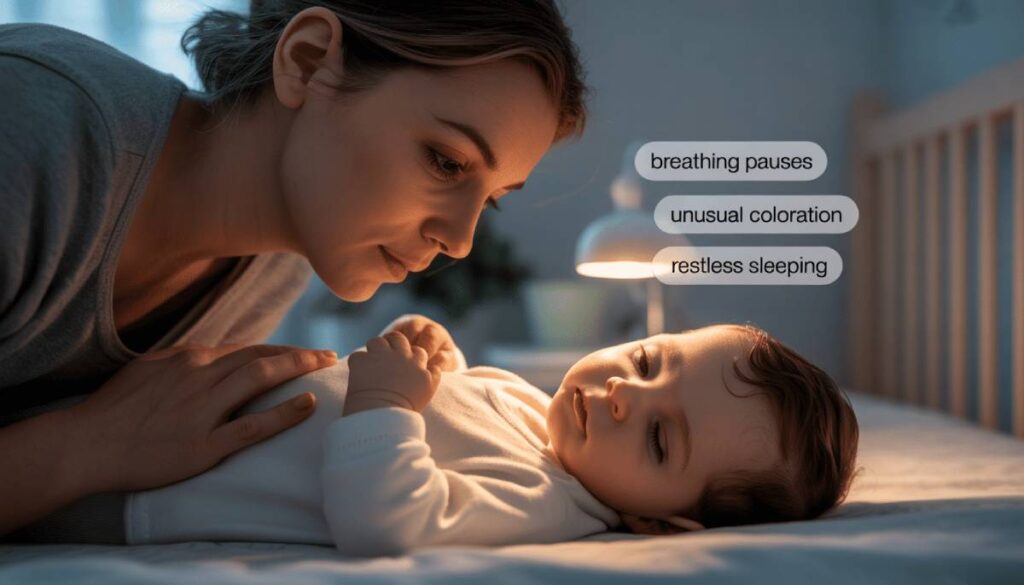
How to Recognize Infant Sleep Apnea
Figuring out if your baby has sleep apnea can be tricky. Parents, keep a lookout for these eye-opening signs:
- Frequent Pauses in Breathing: Notice if your baby often stops breathing for short periods while snoozing.
- Snoring: Hear your baby snoring consistently? That’s not typical—could be a red flag.
- Choking or Gasping: Is your baby making choking or gasping sounds in their sleep?
- Restless Sleeping: Frequent tossing, turning, or waking up could mean trouble.
- Sweating: More perspiration during sleep, thanks to all the effort of trying to breathe.
- Cyanosis: If your baby’s skin turns blue or pale, especially around the mouth, it’s a sign of low oxygen levels.
- Difficulty Feeding: Struggles with breastfeeding or bottle can hint at breathing issues.
- Daytime Sleepiness: Extra drowsy or lethargic baby during the day after a rough night’s sleep.
- Growth Retardation: Slow growth can be a clue something’s up with their sleep.
Curious about more symptoms? Take a look at our full article on sleep apnea symptoms.
Here’s a handy table with the symptoms laid out:
| Symptom | Description |
|---|---|
| Pauses in Breathing | Frequent stops during sleep |
| Snoring | Odd, consistent snoring sounds |
| Gasping/Choking | Sounds like gasping or choking while asleep |
| Restlessness | Constant wriggling and waking at night |
| Sweating | Heavy sweating during zzz’s |
| Cyanosis | Skin looking blue or pale, especially facially |
| Difficulty Feeding | Issues with bottle or breastfeeding |
| Daytime Sleepiness | Out-of-the-ordinary drowsiness in daylight |
| Growth Retardation | Slower growth than expected |
When to Consult a Healthcare Professional
Seeing any of these signs? Time to give the doc a ring. An early heads-up can mean quick diagnosis and treatment, keeping possible health problems at bay. When should you make that call?
- Persistent Symptoms: Symptoms are not just once in a blue moon—they keep coming back.
- Breathing Difficulties: Major breathing problems like long pauses or blue lips.
- Feeding Issues: Ongoing trouble with feeding affecting your little one’s weight.
- Daytime Behavioral Concerns: Too much sleepiness or lacking energy during the day.
For the lowdown on what happens at the doc’s, pop over to our sleep apnea diagnosis breakdown.
Ignoring sleep apnea might mess with your baby’s growth and development. Want to know more? Check out the side effects of letting sleep apnea run wild.
By catching these cues and knowing when to get professional advice, you make sure your baby gets the right care. For more help, peek at our infant sleep apnea resources and ideas for handling sleep apnea in kids.
Diagnosis and Treatment
Diagnostic Process for Infant Sleep Apnea
Figuring out sleep apnea in babies ain’t just guesswork; it involves some serious detective work to get it right. Catching it early on is important so the little one gets the right help straight off. Here’s usually how it goes down:
- Medical History and Physical Check-Up: First off, the doc will take a stroll down memory lane with the baby’s medical history and conduct a detailed physical exam.
- Sleep Study (Polysomnography): This all-night sleep study’s like the heavyweight champ of tests, and it tracks brain waves, eye flicks, heartbeat, breathing, oxygen, and even those tiny limbs.
- Pulse Oximetry: This handy test measures how well the blood’s pumping oxygen through the night, using a nifty clip that’s gentle on the little one.
- Extra Tests: If needed, fancy tests like ECGs or some imaging might be on the cards.
| Diagnostic Method | What’s Involved | Why Do It? |
|---|---|---|
| Medical History | Past health stories and ongoing issues | Get the full picture |
| Physical Check-Up | A health pro gives the baby a good once-over | Find any obvious signs |
| Polysomnography | Sleep monitoring with multiple checkpoints | Detailed diagnosis |
| Pulse Oximetry | Quick and easy oxygen check during sleep | Initial assessment |
| Extra Tests | ECGs, imaging, might be necessary | Deep dive when needed |
For the nitty-gritty on the tests, take a peek at our detailed guide on sleep apnea diagnosis.
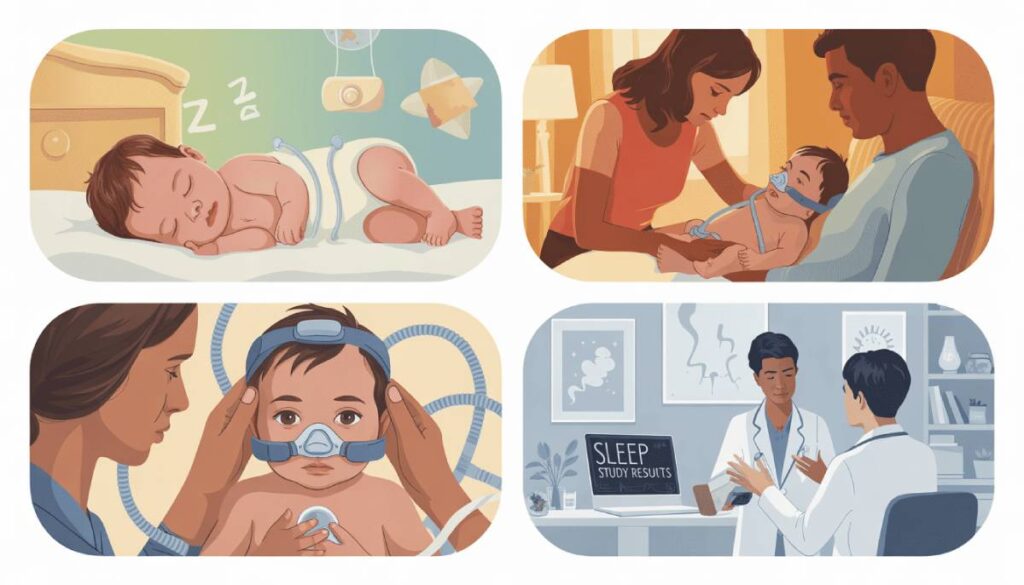
Treatment Options for Infant Sleep Apnea
If sleep apnea has settled in with the young one, there’s a menu of treatments to choose from. What works best depends on how serious it is and what’s causing it.
- Lifestyle and Environmental Adjustments: For cases on the mild side, tweaking where and how the baby sleeps could do the trick. Keep things smoke-free and lay the little tyke on their side or back.
- Continuous Positive Airway Pressure (CPAP): When things are a bit more serious, CPAP saves the day, delivering a steady breeze of air through a mask to keep those tiny airways open.
- Surgery: If push comes to shove, surgery might be needed—like evicting pesky tonsils if they’re causing trouble.
- Medications: Some meds might help combat underlying issues like GERD that play into the apnea drama.
- Special Medical Gadgets: Some kiddos might need a custom gizmo to help keep that crucial airway clear.
| Treatment Option | What’s Involved | Best For |
|---|---|---|
| Lifestyle Tweaks | Changes in baby’s sleep habits and surroundings | Mild Apnea |
| CPAP | Steady airflow through a mask | Moderate to Severe Cases |
| Surgery | Snipping problem bits like tonsils | Blocking problems |
| Meds | Pills for conditions that worsen apnea | GERD, allergy-related |
| Special Gadgets | Personalized tools to keep airway open | Specific cases |
Need more info on treatments? Our piece on sleep apnea treatment has got you covered.
Getting the right diagnosis and thinking through treatments can help parents handle sleep apnea for their little ones. Always check in with healthcare pros to choose the best plan for your baby.
For parents looking for more ideas, see our sections on natural remedies for sleep apnea and sleep apnea solutions.
Impact on Infants
Okay folks, let’s talk about something that’s serious yet super important – sleep apnea in babies. This isn’t just a quick yawn or two; it can have some pretty big ripple effects on your little one’s health.
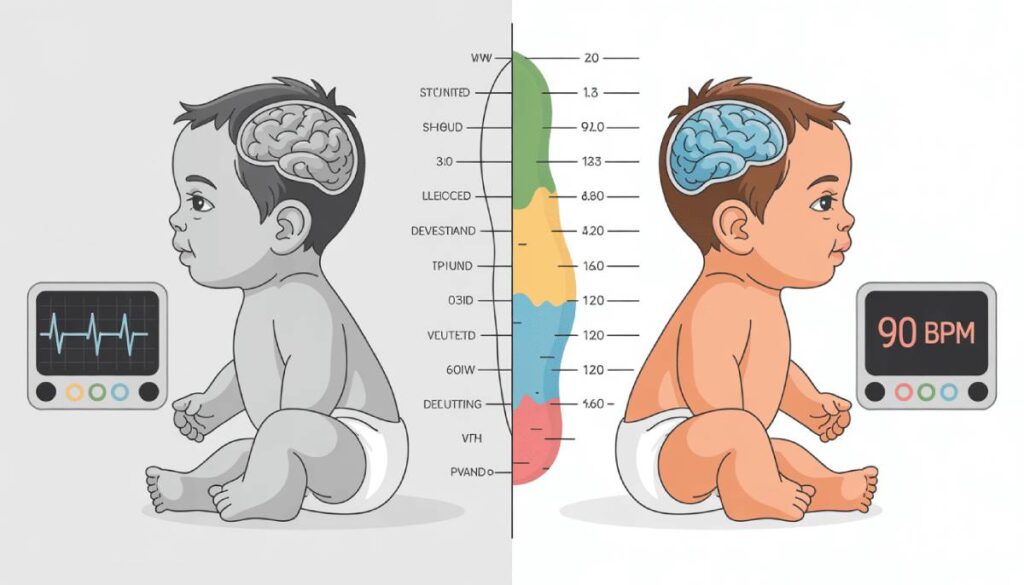
Short-Term Effects of Untreated Sleep Apnea in Infants
If your baby has sleep apnea, things can get a bit rocky right away. Here’s what goes down in Kiddo Land:
- Broken Snooze Sessions: Those breathing breaks mess up sleep cycles, making nap time not-so-restful.
- Crabby Pants Alert: Less sleep equals cranky baby. Expect some mood swings that put teenage drama to shame.
- Bottle Battles: Getting tired from all that broken sleep makes feeding a big yawn-fest—and not in a good way.
- Slow on the Pickup: Not enough shut-eye can delay learning first steps and first words.
- Weight Whackiness: Some babies might slim down, while others bulk up thanks to shifty sleep.
| Effect | Frequency |
|---|---|
| Broken Snooze | Frequent |
| Crabby Pants | Common |
| Bottle Battles | Common |
| Slow on Pickup | Potential |
| Weight Whackiness | Possible |
Want more scoop on how to spot this? Dash over to our sleep apnea symptoms page.
Long-Term Consequences of Infant Sleep Apnea
Let’s face it, if left hanging, sleep apnea can really throw a wrench in things over the long haul. Here’s the skinny on what might come up:
- Forever Tired: Keep messing with sleep and you’re looking at a zombie-like existence.
- Wigged-Out Behavior: Act up much? Sleep issues could mean a hyperactive, distracted chatterbox.
- Growing Pains: Ditching good sleep might slow down physical and mental development.
- Heart Trouble Coming Up?: Low oxygen at night could set them up for heart problems later on.
- Sick All the Time: If sleep’s a mess, so’s the immune system—expect more coughs and sniffles.
| Long-Term Effect | Potential Impact |
|---|---|
| Forever Tired | High |
| Wigged-Out Behavior | Big-Time |
| Growing Pains | Major |
| Heart Trouble? | More Likely |
| Sick All the Time | On the Radar |
Knowing this stuff is like getting a head start in stopping sleep apnea from giving your baby a rough ride. For a chat about fixing this, hit up our sleep apnea treatment article. And for a heads up on dodging these issues or for more parent back-up, check out sleep apnea risk factors plus nifty coping hacks. Keep those little ones healthy and happy!
Risk Factors and Prevention
Getting a grip on what can make sleep apnea more likely in little ones—and how to keep it at bay—is something every parent and caregiver should know.
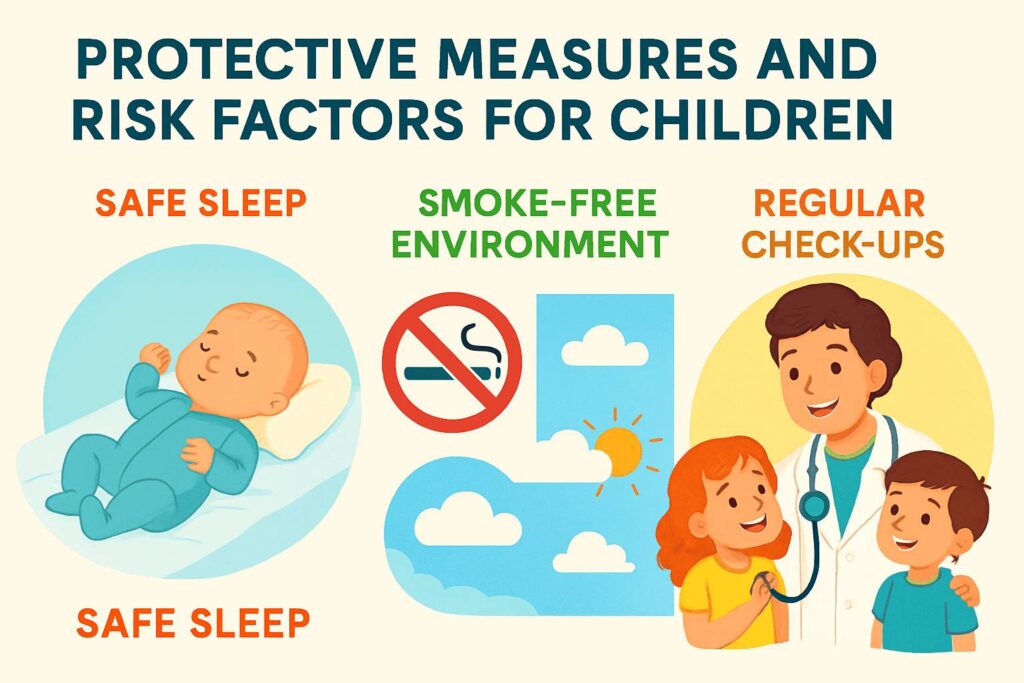
Factors that Increase the Risk of Infant Sleep Apnea
A mix of things might boost the chances of an infant having sleep apnea. Knowing about these factors can help you spot issues early and deal with them promptly.
| Risk Factor | Description |
|---|---|
| Premature Birth | Babies arriving ahead of schedule, especially before the 37-week mark, might have underdeveloped lungs, upping the risk. |
| Obesity | Carrying extra weight can squash airways, leading to obstructive sleep apnea. |
| Family History | If sleep apnea runs in the family, your little one might be more prone to it too. |
| Nasal Congestion | Persistent stuffy noses can block air passages and trigger sleep apnea. |
| Environmental Smoke | Breathing in smoke from the environment can irritate and inflame airways, raising the risk. |
Wanna dive deeper into what causes sleep apnea in infants? Check out our sleep apnea causes article.
“Understanding the difference between obstructive and central sleep apnea is crucial for proper treatment. What works for one type may not work for the other.” – Dr. Michael Breus, Clinical Psychologist and Sleep Specialist
Preventive Measures for Infant Sleep Apnea
Here’s what parents can do to steer clear of sleep apnea issues in babies:
- Monitor Sleep Environment: Make sure the baby’s sleep space is smoke-free and clear of irritants.
- Healthy Weight: From the get-go, engage in practices that help maintain a healthy weight to ward off problems linked to obesity.
- Proper Sleep Position: Always put infants to sleep on their backs to help fend off blocked airways.
- Regular Check-Ups: Keep those pediatric appointments to catch any early hints of sleep apnea.
- Breastfeeding: Think about breastfeeding, as it seems to lower the chances of sleep apnea in babies.
By sticking to these tips, parents can seriously cut down the odds of their babies getting sleep apnea. Want more ideas on better sleep practices and making a safe snooze spot for your little one? Visit our guide on natural remedies for sleep apnea.
Getting familiar with both risk factors and preventative actions means parents can act smartly to keep their babies healthy and happy. Swing by our all-encompassing guide on infant sleep apnea for more detailed info and handy resources.
Support for Parents
Parents caring for infants with sleep apnea face their fair share of challenges. Figuring out how to manage these can really make a difference for both the kid and their folks.
Coping with a Child with Sleep Apnea
Handling a baby with sleep apnea isn’t a walk in the park. You’ve got to create a cozy setup and make sure they’re getting the right medical help.
- Education: First off, get the scoop on sleep apnea in infants. Parents should huddle up with doctors and check out trusted sources to get a grip on symptoms and treatments.
- Monitoring: Keep an eye on that little one’s sleep pattern. A sleep journal can highlight those apnea moments and any strange symptoms, which turn into handy notes for the doctor’s visits.
- Routine: Set up a solid bedtime gig. A steady sleep schedule makes it easier to spot anything fishy.
- Support Groups: Tapping into support groups or online hangouts with other parents dealing with sleep apnea offers some much-needed advice, high-fives for the stuff you do right, and a sense of camaraderie that makes the journey less lonely.
- Professional Guidance: Stay in touch with pediatricians or sleep experts. These pros can tweak ongoing treatment and lend an ear when needed.
- Self-Care: Don’t forget the need to take care of the caregivers. Getting enough shut-eye and having a vent-session or two keeps parents in tip-top shape for their little ones.
Resources for Parents of Infants with Sleep Apnea
There’s a whole slew of resources out there to help guide parents along this journey. Here’s a peek at what’s on offer:
| Resource Type | What You Get |
|---|---|
| Healthcare Providers | Chat with pediatricians, sleep wizards, and breathing therapists to get the lowdown on diagnosis, treatment, and tips. |
| Support Groups | Whether online or face-to-face, these groups offer a space to swap stories and share survival tips. |
| Educational Materials | Discover books, articles, and websites about sleep apnea in babies to gather coping strategies. |
| Helplines | Some lines are buzzing with experts ready to dish out advice and support for parents tackling sleep apnea. |
| Community Resources | Local health hubs and charities might have an info stash for parents grappling with kiddo sleep issues. |
Tapping into these resources helps parents get a handle on sleep apnea, leading to more effective management of this condition. For more in-depth deets on aspects like sleep apnea symptoms or sleep apnea treatment, take a gander at our other articles.
Main Tips
- Position babies on their backs during sleep to reduce apnea risk
- Keep the sleep environment free from smoke, allergens, and respiratory irritants
- Monitor and record unusual breathing patterns to share with healthcare providers
- Learn infant CPR as a precautionary safety measure
- Maintain regular pediatric check-ups, especially for premature infants
- Consider room-sharing (not bed-sharing) for easier monitoring during early months
- Avoid overdressing babies or overheating the sleep environment
- Be particularly vigilant during illnesses that affect breathing
- Create a detailed sleep journal if you suspect sleep apnea
- Trust your parental instincts—if something seems wrong with your baby’s breathing, seek medical advice
Conclusion
Infant sleep apnea represents a significant but manageable health challenge that demands attention, understanding, and proactive care from parents and healthcare providers. The journey from recognition to diagnosis and treatment may seem daunting, but each step taken is an investment in your child’s long-term health and development. By learning to identify the telltale signs—those interrupted breaths, unusual sounds, and behavioral changes—parents can initiate the vital conversations with medical professionals that lead to effective interventions.
The impacts of untreated sleep apnea extend far beyond disrupted nights, potentially affecting cognitive development, physical growth, and cardiovascular health. Yet with early detection and appropriate treatment, ranging from simple environmental adjustments to medical interventions, most infants can overcome these breathing difficulties. As medical understanding of infant sleep apnea continues to evolve, so too do the treatment options and support resources available to families navigating this challenge. Remember that you’re not alone in this journey—healthcare providers, support groups, and other parents who have walked this path stand ready to offer guidance, understanding, and encouragement.
Resources
- American Academy of Pediatrics – Healthy Children: Sleep Apnea
- National Sleep Foundation – Children and Sleep Apnea
- Sleep Apnea Foundation – Pediatric Sleep Apnea
- CDC – Safe Sleep for Babies
Final Thoughts
The journey through infant sleep apnea can feel overwhelming, but knowledge truly is power in this situation. By understanding what to look for, when to seek help, and how treatments work, parents can navigate this challenge with confidence and composure. Remember that many infants outgrow sleep apnea as their respiratory and nervous systems mature, but proper medical oversight during this process is essential.
What makes addressing infant sleep apnea particularly important is how it sits at the intersection of immediate comfort and long-term development. Quality sleep is fundamental to brain development, physical growth, and emotional regulation in infants. By addressing sleep apnea promptly, parents aren’t just helping their babies breathe better at night—they’re protecting their developmental trajectory and setting them up for healthier futures.
If you suspect your infant might be experiencing sleep apnea, don’t hesitate to reach out to healthcare providers. In the realm of infant health, it’s always better to investigate concerns thoroughly rather than dismiss them. Your attentiveness and advocacy may make all the difference in your child’s health journey.
Recommended Products
Essential Monitoring and Sleep Support for Infants with Sleep Apnea
| Product | Description | Benefits |
|---|---|---|
| Owlet Smart Sock Plus | Advanced baby monitor that tracks heart rate, oxygen levels, and sleep patterns | Provides real-time monitoring with smartphone alerts for breathing abnormalities |
| Hatch Rest Sound Machine & Night Light | Customizable sound machine, night light, and time-to-rise alert system | Creates optimal sleep environment with white noise to promote better breathing patterns |
| Crane Ultrasonic Cool Mist Humidifier | Child-friendly humidifier with filter-free operation | Maintains optimal humidity to reduce nasal congestion and support easier breathing |
| Infant Wedge Sleep Positioner | Doctor-recommended sleep positioner with 12-degree incline | Helps reduce reflux and improves breathing by elevating head and chest |
| Newton Baby Crib Mattress | Breathable, washable crib mattress promoting airflow | Reduces risk of rebreathing CO2, supporting better overnight breathing |
| Fridababy NoseFrida Snotsucker | Doctor-designed nasal aspirator with disposable filters | Effectively clears nasal passages to improve breathing before sleep |
| Vicks BabyRub Soothing Vapor Ointment | Gentle non-medicated formula with calming aromatherapy | Soothes and comforts with aromatic vapors that can help support clear breathing |
| Infant Pulse Oximeter | Portable oxygen monitoring device sized for infants | Allows for spot-checking oxygen levels during sleep with digital display |
Choose the right combination of these products based on your pediatrician’s recommendations and your baby’s specific needs. Regular monitoring and maintaining a proper sleep environment can significantly improve outcomes for infants with sleep apnea.

